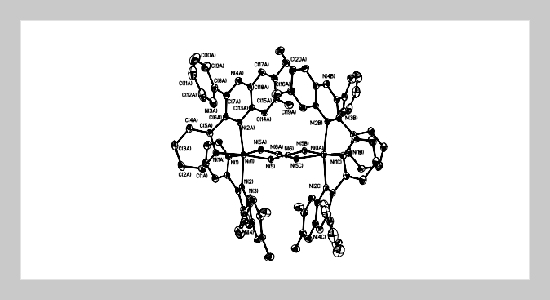Chun-Yuan Liao1, Ho-Hsiang Wei This email address is being protected from spambots. You need JavaScript enabled to view it.1, Sheng-Chuan Cheng1 and Sasankasekhar Mohanta1 1Department of Chemistry Tamkang University Tamsui, Taiwan 251, R.O.C.
Received:
September 9, 2002
Accepted:
October 7, 2002
Publication Date:
December 1, 2002
Download Citation:
||https://doi.org/10.6180/jase.2002.5.4.01
Two new N3-bridged dinuclear nickel(II) complexes, [Ni(ddqx)2 (µ1,3-N3)]2(ClO4)2⋅8CH3OH 1 and [Ni(tpd)(µ1,1-N3)(H2O)]2 2, (ddqx = 2,6-dimethyl-2,3-bis(2-pyridyl)quinoxaline and Htpd = 4-terpyridone = 2,6-bis(2-pyridyl)-4(1H)-pyridone), have been synthesized. Complex 1 crystallizes in the orthorhombic system with Ccca space group; the structure consists of isolated dimer and each Ni(II) atom is coordinated by two bidentate ddqx ligands and two end-to-end µ1,3-N3 groups. Complex 2 crystallizes in monoclinic P21/n space group; the structure consists of hydrogen-bonding linked 2-D chain of dinuclear Ni(II) complex, and each Ni(II) atom is coordinated by tridentate tpd ligand, water molecule and bridging µ1,1-N3 ligand; the hydrogen bonding formed between the hydrogen atom of H2O and oxygen atom of tpd ligand. Magnetic susceptibility data, measured from 2-300 K, reveal that complex 1 exhibits antiferromagnetic interaction with J = −29 cm-1, D = 10 cm-1, g = 2.0, whereas complex 2 exhibits ferromagnetic interaction with J = 17 cm-1, D = −8.5 cm-1, g = 2.18. The magneto-structural correlation has been discussed.ABSTRACT
Keywords:
Azide bridged, Dinickel(II), Crystallographic Equivalence, Distortion of Azide Bridge.
REFERENCES
















